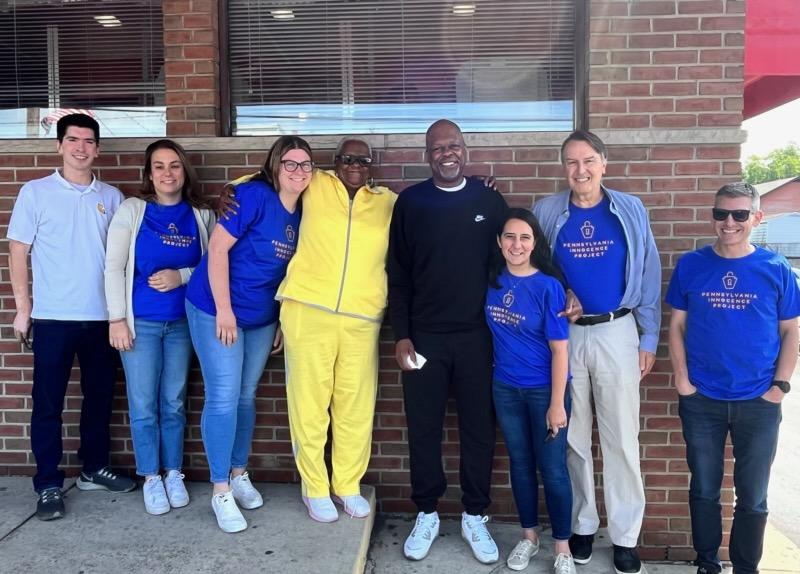LaFaye Gaskins
LaFaye's Story

LaFaye Gaskins -- Free after 34 Years of Wrongful Incarceration
On June 9, 2023, LaFaye Gaskins walked out of the Pennsylvania State Correctional Institution at Mahanoy, a place he thought he would never leave, and straight into his mother’s arms after enduring 34 years of wrongful incarceration for a murder he did not commit. LaFaye was also greeted by his legal team, including Pennsylvania Innocence Project attorneys Nilam Sanghvi and Amelia Maxfield, former Project investigator John Butler, and three attorneys from Schnader Harrison Segal & Lewis LLP—Ralph Wellington, Edward Sholinsky, and Alexandra Fahringer. Alex has been working on LaFaye’s case since her law school internship at the Pennsylvania Innocence Project. LaFaye is looking forward to spending time with his family and friends, especially his daughter Onia, who was born just before he went to prison and was recently honorably discharged from the US Navy.
How did this happen?
LaFaye's Wrongful Arrest and Conviction
In June 1989, LaFaye, just 20 years old at the time, was watching Crimefighters with his girlfriend when he saw himself on the show—police wanted him for a murder. LaFaye called his mother Myra, who confirmed police had been looking for him and advised him to turn himself in. LaFaye did so, thinking he would easily clear up this misunderstanding. Instead, he started his decades-long journey through wrongful conviction.
In 1990, a jury convicted LaFaye of first-degree murder and related charges for the February 1989 murder of Albert Dodson. The conviction was based on the thinnest of evidence—two “eyewitnesses,” Gloria Pittman and Edward Clyburn, neither of whom, as the prosecution acknowledged at trial, even saw the crime. Indeed, no one even knew precisely when the crime occurred as Dodson’s body was completely frozen by the time it was found in an abandoned house.
In an interview shortly after the body was discovered, Pittman told police she had heard shots and saw a man running away from the house a few days earlier, but “did not see face.” A few months later, however, she somehow identified that man as LaFaye in a group of photographs. The Commonwealth built its case around Pittman, emphasizing to the jury that Pittman placed LaFaye in close proximity to the abandoned house at the supposed time of Dodson’s shooting.
The court sentenced LaFaye, at age 21, to life without parole.
LaFaye's quest to prove his innocence...
For decades after his conviction, LaFaye, who entered prison with an 8th grade education and later obtained his GED, and his mother Myra attempted, on their own, to find new evidence to prove his innocence. They never had money to pay for attorneys, so LaFaye wrote hundreds of letters to attorneys asking for help. No one helped him, but Myra asked him to send thank you letters to the people who took the time to tell him no, because at least they had responded.
In the mid-2000s, LaFaye learned from a family member that Pittman said she had been paid to testify. LaFaye, representing himself, filed a post-conviction petition based on this information, which was denied as untimely. Nevertheless, LaFaye and Myra persisted in a years-long quest to obtain documentation from Pittman directly—a quest that led to a 2012 letter from Pittman to LaFaye and then a sworn affidavit in which she recanted her identification and expressed her desire for LaFaye to see justice.
LaFaye, still representing himself, filed another petition seeking a new trial. The court again denied the petition as untimely. LaFaye appealed. The Pennsylvania Superior Court agreed with LaFaye and sent the case back to the Court of Common Pleas to look more closely at whether LaFaye had filed his petition on time. The appellate court noted that Pittman’s statement presented a critical new fact: that she went to court and identified LaFaye because police coerced her. They told her they were going to lock her up if she did not testify.
In 2019, the Pennsylvania Innocence Project and Schnader Harrison team began representing LaFaye after investigating his case for years. We supplemented the work that LaFaye had already done, amending the petition to include an expert report from Temple University Beasley School of Law Professor Jules Epstein highlighting the risk of mistaken identifications of LaFaye by both “eyewitnesses.” We also conducted a crime scene investigation, which showed that Pittman would have had a very limited view of the man she claimed to see leaving the abandoned house.
We presented this critical evidence at a hearing in 2022. However, in another terrible injustice, Pittman’s testimony at the hearing was not recorded due to a problem with the court’s systems. After that hearing, the Commonwealth, which had vigorously opposed LaFaye every step of the way, changed its position and offered to agree to have LaFaye’s conviction vacated if he agreed to then immediately plead guilty to third-degree murder and related charges, resulting in a sentence that would allow him to be released. LaFaye, who has always maintained his innocence, made the difficult decision to accept this plea, knowing it might be his only chance to come home.
See a short video spotlight on LaFaye's story:
You can read more about LaFaye's case here:
You can learn more about issues related to mistaken eyewitness identifications, which is one of the leading causes of wrongful convictions, here: